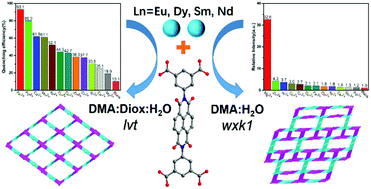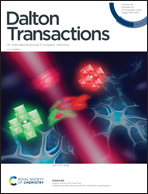Two series of Ln-MOFs by solvent induced self-assembly demonstrating the rapid selective sensing of Mg2+ and Fe3+ cations†
Abstract
Two series of lanthanide-based metal–organic frameworks, namely {[Ln(BIPA-TC)0.5(DMA)2(NO3)]·DMA·H2O}n (1-Ln, Ln = Eu, Dy, Sm, Nd) and {[Ln2(BIPA-TC)1.5(DMA)3(H2O)2]·2DMA·2H2O}n (2-Ln, Ln = Eu, Dy, Sm, Nd), were successfully constructed via a solvent regulation strategy based on a π-electron rich tetra-carboxylate ligand (H4BIPA-TC). 1-Ln shows a 4-connected lvt topology with the point symbol of {42·84}, but 2-Ln displays a new 4,4,6-connected wxk1 topology with the point symbol of {43·83}4{46·66·83}2{86}. The solid-state luminescence property and the microporous nature of Eu-MOFs (1-Eu and 2-Eu) indicate that they can potentially be used as luminescent sensors. Fluorescence measurements indicate that Fe3+ exhibits the quenching effect for 1-Eu with the quenching efficiency of 93.1%. 2-Eu is the first MOF sensor for Mg2+ with the lowest detection limit of 1.53 × 10−10 mol L−1 and displays good recyclable capability. Simultaneously, in the presence of other metal ions (Ca2+, Mn2+, Co2+, Ni2+, Cu2+, Zn2+, Cd2+, Pd2+, Al3+, Cr3+and Fe3+), 2-Eu can maintain the selective sensing of Mg2+, indicating its potential for Mg2+ turn-on sensing.



 Please wait while we load your content...
Please wait while we load your content...